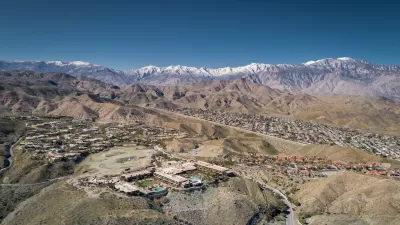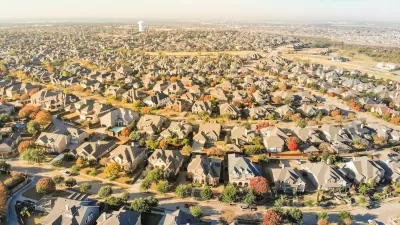Chasing the widespread interest in city living, developers are exporting mixed-use urbanism to the suburbs and exurbs as "town center" projects, prompting Jonathan O’Connell to ask if "a city can be a city if it’s built in the middle of a cornfield."
Across America, builders are increasingly catching on to the value of the urban experience, and creating town center or "lifestyle center" projects (to the tune of 398 by the end of 2011) in suburbs, exurbs, and "on farmland alongside a highway." O'Connell looks at examples from around Washington D.C., such as the Village at Leesburg, where developers, "are aiming to replicate the culture and convenience of cities, minus their traffic and crime."
"Critics of town centers," contends O'Connell, "consider them soulless corporate replicas - no
more real cities than Disney World's fairy-tale fiberglass-and-concrete
showpiece is a real castle." As it becomes "harder to distinguish what makes a city a city," does it matter if every attempt to export mixed-use urbanism to the suburbs can't replicate the feel of Williamsburg in Brooklyn or U Street in D.C.?
"Developer and D.C. native Jair Lynch warned recently that suburban
city-like centers could steal the District's thunder. 'Just like the
suburbs kicked our butt on retail in the 1980s, that's exactly what's
going to happen with these transit-oriented, urban neighborhoods that
are coming up now,' he said." After all, says O'Connell, "At one point, even the most hardened and historic urban neighborhoods were shiny and new."
Developer Anthony Lanier, who "rebuilt Georgetown block by block," has a different perspective, however. "The feeling of walking down M Street in Georgetown or on U Street cannot
be duplicated, Lanier argues, because these areas were built not by a
developer with a singular vision but by time."
FULL STORY: Can city life be exported to the suburbs?

Study: Maui’s Plan to Convert Vacation Rentals to Long-Term Housing Could Cause Nearly $1 Billion Economic Loss
The plan would reduce visitor accommodation by 25,% resulting in 1,900 jobs lost.

Alabama: Trump Terminates Settlements for Black Communities Harmed By Raw Sewage
Trump deemed the landmark civil rights agreement “illegal DEI and environmental justice policy.”

Why Should We Subsidize Public Transportation?
Many public transit agencies face financial stress due to rising costs, declining fare revenue, and declining subsidies. Transit advocates must provide a strong business case for increasing public transit funding.

Paris Bike Boom Leads to Steep Drop in Air Pollution
The French city’s air quality has improved dramatically in the past 20 years, coinciding with a growth in cycling.

Why Housing Costs More to Build in California Than in Texas
Hard costs like labor and materials combined with ‘soft’ costs such as permitting make building in the San Francisco Bay Area almost three times as costly as in Texas cities.

San Diego County Sees a Rise in Urban Coyotes
San Diego County experiences a rise in urban coyotes, as sightings become prevalent throughout its urban neighbourhoods and surrounding areas.
Urban Design for Planners 1: Software Tools
This six-course series explores essential urban design concepts using open source software and equips planners with the tools they need to participate fully in the urban design process.
Planning for Universal Design
Learn the tools for implementing Universal Design in planning regulations.
Smith Gee Studio
Alamo Area Metropolitan Planning Organization
City of Santa Clarita
Institute for Housing and Urban Development Studies (IHS)
City of Grandview
Harvard GSD Executive Education
Toledo-Lucas County Plan Commissions
Salt Lake City
NYU Wagner Graduate School of Public Service





























